Container Garden Ideas
Dress up your garden with these container planting ideas for gorgeous planters full of flowers, veggies, and more.
'Violet Eclipse' container recipe: Supertunia® Sharon, Supertunia® Royal Velvet®, and Supertunia® Magenta® petunias; Angelface® Blue angelonia. Photo: Proven Winners
Container gardening is a fun, flexible way to bring vibrant color, texture, and greenery to any space—from patios and porches to balconies and backyards. Whether you're looking for creative container garden ideas, tips for designing eye-catching displays, or the best plants to grow in pots, you've come to the right place.
In this guide, you'll find inspiration for every season, expert plant selection advice, and practical container gardening tips to help your planters thrive. Browse the sections below to start planning your perfect container garden!
Tip: Use the table of contents to jump straight to the section you're most interested in, whether it's planting ideas, care tips, or container design inspiration.
On this page:
- CONTAINER GARDEN IDEAS FOR EVERY SEASON
- PLANT SELECTION FOR CONTAINER GARDENS
- CHOOSING THE RIGHT CONTAINER
- PLANTING YOUR CONTAINERS
- CONTAINER CARE & MAINTENANCE
- DESIGN TIPS FOR BEAUTIFUL CONTAINERS
- FREQUENTLY ASKED QUESTIONS
- TIPS FROM OUR READERS
CONTAINER GARDEN IDEAS FOR EVERY SEASON
Discover creative container garden ideas to inspire your plantings year-round—from bold summer arrangements to festive winter pots and everything in between.

Container designs that combine architectural presence, sultry colors, and abundant textures.
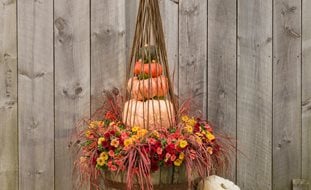
Try something new with your fall containers. Get ideas and inspiration with some of our fall favorites.
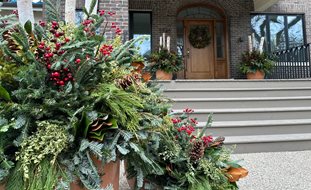
14 thoughtful containers that celebrate the garden-and the season.
PLANT SELECTION FOR CONTAINER GARDENS
Choosing the right plants is essential for container gardening success. Look for combinations that thrive in the same light and water conditions, and think about color, texture, and growth habits when designing your mix.
Environment:
Match sun and water needs across all plants in a container. Choose from our guides to the best plants for full sun or shade-loving container plants.
Flowers & foliage:
The best container combinations mix long-blooming flowers with foliage that adds color, texture, or contrast. Don’t rely on flowers alone — foliage often lasts longer and carries the design through seasonal changes.
Three main roles:
- Thriller: Tall, focal plant
- Filler: Mounding plant to add fullness
- Spiller: Trailing plant that softens edges
Color tips:
- Pinks, blues, and purples work well together
- Reds, oranges, and yellows add bold contrast
- White, silver, pale yellow, and chartreuse pair with almost anything
- Also consider the color and style of your container as part of the palette
Swapping plants midseason
Need a change? Use a knife to cut around the root ball of any plant you want to replace. Remove it and plug in a new one — within a week, it’ll look like it was always part of the design.

Suggestions for some of the best plants for full sun containers.
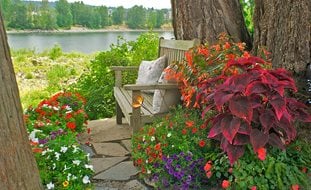
Solutions for livening up shady areas and 11 plants that will thrive in low light.

Grow perennial plants in containers for years of reliable color.

Add long-lasting color to containers with perennial plants that reward with years of color.

Tips for planting, growing, and caring for a patio-friendly rose garden.

Add color to a patio, deck, or balcony with lantana in pots.
CHOOSING THE RIGHT CONTAINER
The right container doesn’t just hold your plants — it supports healthy growth, complements your design, and enhances the overall look of your garden.
Ensure proper drainage:
You can plant directly into almost any container, as long as it has drainage holes. Drilling through wood, plastic, or fiberglass is relatively easy. For clay pots, use an electric drill with a masonry bit — but work carefully to avoid cracking.
Invest in quality:
When buying large containers, choose the best quality you can afford. Classic shapes and neutral styles tend to work across many garden designs and will last longer than trend-driven colors or patterns.
Match containers to your home:
Let the materials and style of your house guide your container choices.
- Match brick walls with terra-cotta pots
- Pair a white colonial home with classic lead (or faux-lead) planters
- Use weathered copper tubs or wooden troughs for rustic timber homes
Choose the right shape:
A tall, narrow pot is less stable than a wide, low one. Use tall containers for lightweight, trailing plants that cascade down. Place shallower containers, like alpine pans, toward the front of a display to anchor the group visually.
Avoid difficult shapes:
Skip narrow-necked pots with wide bodies—once a plant's roots fill the space, it becomes difficult to remove. (That's why most traditional flowerpots are wider at the top.)
Simplify your display:
Not every plant needs a fancy pot. Use basic black plastic nursery pots for most plants, and simply group them behind decorative containers to create a cohesive and low-maintenance look.
AquaPots® Self-Watering Containers
Unmatched design, refined colors, and unprecedented finishes make AquaPots a favorite among retailers, landscape professionals, and home gardeners. Hundreds of unique designs in multiple sizes, colors, and finishes are available.
Top 4 reasons to invest in AquaPots:
1. Highest quality finishes of any ceramic planters
2. Most durable planters on the market
3. Trendsetting colors and finishes
4. New designs every year
PLANTING YOUR CONTAINER
Learn the basics of planting beautiful containers, from choosing the right soil to arranging plants for the best visual effect and healthy growth.
Planting mix:
Start with a commercial, peat-based, soilless mix. These mixes retain water better than garden soil and create the ideal environment for root growth. Mix in a slow-release fertilizer at planting time. When filling your container, leave about an inch of space between the soil surface and the rim to allow for watering. (See more: Potting Soil 101)
Plant placement:
For containers placed against a wall or fence, position tall plants at the back so they don't shade smaller companions. In containers placed out in the open, put the tallest plants in the center and surround them with fillers and spillers to create a balanced, 360-degree display.
Top dressing:
To give your container a more polished look and help retain moisture, top dress the soil with gravel, crushed shells, decorative pebbles, or another quick-draining material.
CONTAINER CARE & MAINTENANCE
Keeping your container plants healthy requires the right watering schedule, regular feeding, and simple maintenance tasks to keep them looking their best.
Water:
Plants in containers dry out more quickly than those in garden beds due to limited soil volume and exposure to sun and wind. Water regularly—often daily in hot weather—and aim directly at the base using a watering wand or long-spout can to avoid wetting the foliage. A soil moisture meter is a helpful tool for knowing when to water.
Consistency is key. Setting up a drip irrigation system ensures your containers get water on a reliable schedule—especially helpful during vacations or busy weeks.
Fertilizer:
Frequent watering washes nutrients out of potting mix, so container plants need regular feeding. A small dose of fertilizer applied weekly is far more effective than infrequent, heavy applications.
Deadheading:
Snip off spent flowers and any leggy or damaged growth to keep containers tidy and encourage fresh blooms.
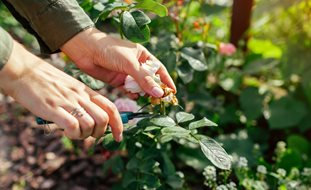
Learn why, how and when to deadhead your garden plants.
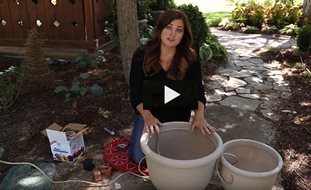
Learn how to set up a drip irrigation system for your containers.

Karen Chapman offers these survival tips to keep them thriving.
DESIGN TIPS FOR BEAUTIFUL CONTAINERS
Learn how to design container gardens that thrive—with smart layout ideas, display strategies, and plant pairing tips to ensure year-round impact.

'Summit Ridge' container recipe: Proven Accents® Illusion® Garnet Lace, Graceful Grasses® Fiber Optic Grass, Graceful Grasses® Vertigo®, Supertunia® Latte™, and Supertunia® White. Photo: Proven Winners
Use small pots strategically:
Small containers can get lost in a larger landscape. Keep them close to patios, doorways, or seating areas where their details can be appreciated. Use pots under 12 inches in diameter to showcase small plants like bulbs, herbs, succulents, and alpines. Rotate them easily based on what’s blooming.
Play with height and levels:
A successful container display uses varying heights to create visual interest. Try a tiered plant stand, stacked pots, or even bricks hidden behind larger containers to raise others to eye level. This adds depth and dimension to your garden design.
Embrace repetition:
Repetition creates cohesion. Place identical plants in matching pots—like agaves in terra-cotta containers—and line them along steps, walls, or walkways to draw the eye and emphasize structure.
Use large containers as features:
Larger containers can act as architectural anchors. Use pairs of clipped boxwood to frame a doorway, tall containers of laurel to define a seating area, or pots of lavender along wide steps for both scent and structure.
Guide movement & views:
Place containers to subtly direct foot traffic—for example, lining a pathway or blocking shortcuts across the lawn. You can also use containers to guide the eye toward seating, focal points, or garden entrances.
Don't forget the saucer:
Use terra-cotta saucers under pots to protect surfaces and add design flair. A large saucer filled with decorative pebbles can help prevent root rot and boost humidity — especially helpful in hot, dry weather.
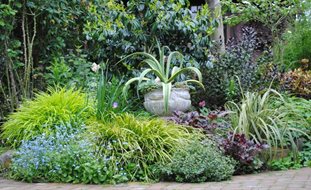
Elevate your garden's design by using containers as problem-solving solutions.

See over 1000 container recipes, all combined perfectly for success.

Browse a collection of photos showing a variety of container gardening ideas.
FREQUENTLY ASKED QUESTIONS
What are the best plants for container gardening?
Look for plants that thrive in your lighting conditions and won’t outgrow their pot. Annuals, herbs, dwarf shrubs, succulents, and ornamental grasses all work well in containers. Be sure to group plants with similar water and sun needs
What size container do I need?
Choose a pot large enough to give roots room to grow and hold moisture — usually at least 12 inches wide for most flowers or veggies. Bigger pots dry out more slowly and are more forgiving for beginners.
Do containers need drainage holes?
Yes—drainage holes are essential to prevent waterlogged roots. If your pot doesn’t have holes, drill them or use a liner pot with proper drainage inside the decorative container.
How often should I water container plants?
Most containers need watering once a day in hot weather, especially smaller pots. Use a soil moisture meter or check with your finger—if the top inch is dry, it’s time to water. Drip systems can help automate watering.
Can you reuse potting soil in containers?
Yes, but it’s best to refresh it. Remove old roots and mix in compost or fresh potting mix to restore nutrients and structure. For best results, replace soil completely every 1–2 seasons.
Can I use garden soil in containers?
It's not recommended to use garden soil in containers as it may compact and hinder drainage. Instead, use a high-quality potting mix designed for containers.
Do I need to fertilize container plants?
Yes, nutrients in potting mix deplete over time. Use a balanced, water-soluble fertilizer every 2-4 weeks during the growing season to keep plants healthy.
TIPS FROM OUR READERS
Discover creative and practical container gardening advice shared by our readers, including their favorite design tricks and plant care secrets.
"Think not just of color, but also texture and leaf sizes." — Susan Nock, SN Garden Design
"Add more plants than you think you’re going to need." — JJ De Sousa, Digs Portland
"Create, mix and match. Don’t be scared!" — Katherine Cain, Vivero Growers
"Have fun with what you’re selecting for the container—mix edibles & annuals, go for texture! A container is that chance to experiment. Experiment with the container itself, too." — Cris Blackstone, Make Scents
"If your planter is deep & wide, be sure to use a foundation type of plant (eg. boxwood), which will remain as your permanent base plant all year. Then play around seasonally with annuals, color & texture as filler & spiller. You can even add more height around the foundation plant as thriller. You’ll be amazed how many artistic & unique styles you can create to enjoy the same pot all year long." — Maryam Yaghoubi Farzaneh, Hortus Life
"Containers are great to place plants right next to seating so you can enjoy plants, and even fragrance, right next to you. They also can bring plants up closer to eye level. Containers are also great to ‘contain’ those beautiful but ‘bully-like’ plants that would otherwise take over the garden in-ground." — Jennifer Nitzky, Landscape Architect
"Adding a layer of rock to the bottom does not help with drainage. Studies have found this actually has the opposite effect. Just cover the hole with a piece of screen before filling the pot." — Janet Sluis, Horticulturist
"For a beautiful summer screen, try curly willow, ginger or bamboo in a trough." — Daniel Ward, Longshadow Planters.








